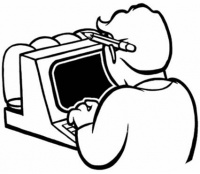GUI
GUI is an acronym and stands for Graphic User Interface. It allows people to interact with game client in Fonline by pressing buttons on it or by watching on it. A Fonline GUI offers graphical icons, and visual indicators, to fully represent the information and actions available to a user. The actions are usually performed through watching the game chat and finishing turn/combat in Turn-Based mode.
Contents |
Standard Fonline GUI
А Standard Fonline GUI offers to a user following info:
- In-game chat
- Changing active item/weapon slot
- Available Action Points (AP)
- Current Health Points (HP)
- Current Armor Class (AC)
- Map - Motion detector button
- Character button
- Inventory button
- Pip-Boy button
- Fix-Boy button
- Skilldex button
- Turn/Combat End button (in Combat Mode only)
User could interact with any button by pressing it on virtual GUI using a mouse or using a keyboard.
Custom GUI's
Currently, there is quite a few of modified interfaces available for every Fonline player. This happens because of insufficient number of available info about interface modding. This becomes the reason of complexity in the development. Nevertheless, there is some interfaces made without of any guides. The following is a list of those interfaces:
- 1024x768 Interface mod 1.0 by WHINE Team
- Minimal Interface by WHINE Team
- Sharp Interface mod by Graf
- HUD Interface mod by Warger
- Printed Circuit Board interface by gurglak
- Combat Interface by Graf
- Fallout 2 Style Interface by Reconite
- Futuristic Combat Interface by seb910
Currently developed GUIs can be found in "Tools and Modifications" on official forum.
Creating your own Fonline GUI
To create a new graphic user interface you'll need - lots of patience and time, some talent and some skill in graphic editors. First of all, to start making a new interface, you should make an image, which will be shown as GUI in the game. It could be maximum as big, as the screen dimension is, but usually it is set at 800x120, 1024x120 or 1280x120, depending on the interface resolution. Setting its height on the size of your chat could save you a lot of time.
Any file could have any name, but it should be written in default.ini, to let the game recognize it as file according to game.After making such image, you should also add button, diode and other graphic files(every button have its own image).To make sure that you did everything correctly, you better download some custom GUI and compare it.
The most difficult thing in modding isn't making graphic files, but working with .ini
Rules for setting coordinates in ini-file:
- Button coordinates usually (if different isn't specified by command type - number) have four coordinates, which are divided by spaces. First two numbers mean distance from left top corner of your button to general top left corner of your GUI. Other two numbers mean distance from right bottom corner to left top corner of your GUI.
- If you want to turn-off any button, then you should set it coordinates to "0 0 0 0" (without quotes)
- It is best to use some simple graphic editor to determine coordinates. Paint or Paint.NET will do.
So, here we go, following is the list of ini-commands, which would help you to make your own interface:
List of ini-commands
| Command name | Command type | Command description |
|---|---|---|
| IntWMainPicNone | Graphic file | Your main screen GUI. It's exactly as on the picture from above. |
| IntWMain | Coordinates | This is for determination of of main GUI window size. |
| IntBItemPicDown | Graphic file | Picture for item/weapon slot |
| IntBItem | coordinates | Setting the size of item/weapon button |
| IntBChangeSlotPicDown | Graphic file | Changing item/weapon slot picture |
| IntBChangeSlot | Coordinates | Item/weapon slot change button |
| IntBInvPicDown | Graphic file | Inventory button picture |
| IntBInv | Coordinates | Inventory button coordinates |
| IntBPipPicDown | Graphic file | PipBoy button picture |
| IntBPip | Coordinates | PipBoy button coordinates |
| IntBMapPicDown | Coordinates | Map (motion detector) button picture |
| IntBMap | Coordinates | Map (motion detector) button coordinates |
| IntBMenuPicDown | Graphic file | System menu (pause) button picture |
| IntBMenu | Coordinates | System menu (pause) button coordinates |
| IntBSkillPicDown | Graphic file | SkillDex button picture |
| IntBSkill | Coordinates | SkillDex button coordinates |
| IntBChaPicDown | Graphic file | Character page button picture |
| IntBCha | Coordinates | Character page button coordinates |
| IntBFixPicDown | Graphic file | FixBoy button picture |
| IntBFix | Coordinates | FixBoy button coordinates |
| IntHp | Coordinates | Health Points indicator coordinates |
| IntAc | Coordinates | Armor Class indicator coordinates |
| IntAPgreenPic | Graphic file | Picture for Action Points diode |
| IntAPredPic | Graphic file | Picture for indicating that you are currently unable to get Action Points (if you are knocked out/knocked down or running) |
| IntAp | Coordinates | Action Points indicator coordinates. If you'll use some special indicator (in shape of round of a star), you should set coordinates from the most wide left corner to the most wide right corner of a picture. |
| IntApStepX | Number | Number of pixels between two Action Points indicators for X axis |
| IntApStepY | Number | Number of pixels between two Action Points indicators for Y axis |
| IntApMax | Number | Number of maximum Action Points indicators available to a user. |
| IntWMess | Coordinates | Command for setting size of in-game chat |
| IntWMessLarge | Coordinates | Command for setting size of enlarged in-game chat |
| IntWAddMessPicNone | Coordinates | A picture which appears over normal in-game chat to enlarge it |
to be continued
